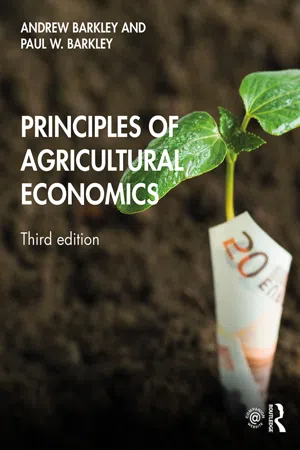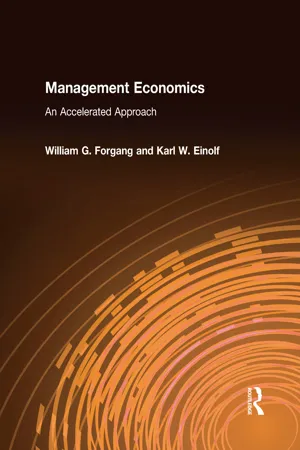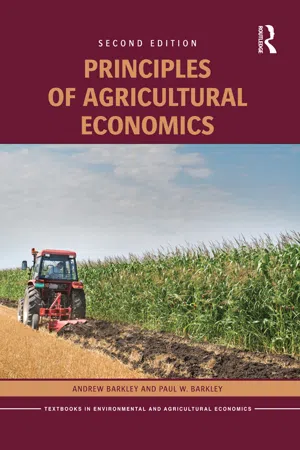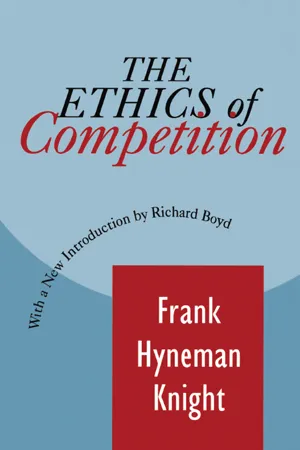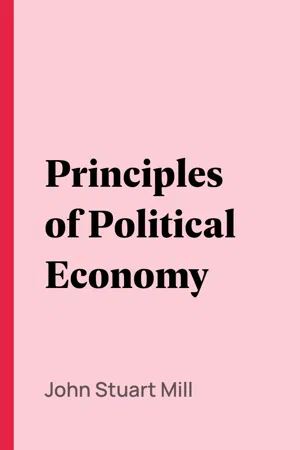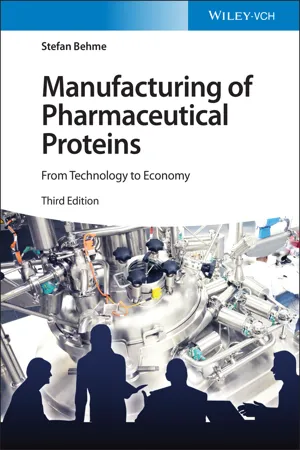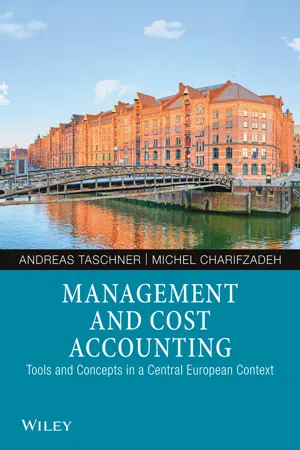Economics
Production Cost
Production cost refers to the expenses incurred in creating goods or services, including the costs of raw materials, labor, and overhead. It encompasses both fixed costs, such as rent and equipment, and variable costs, like wages and materials. Understanding production costs is crucial for businesses to determine pricing, profitability, and efficiency.
Written by Perlego with AI-assistance
Related key terms
9 Key excerpts on "Production Cost"
- eBook - ePub
- Andrew Barkley, Paul W. Barkley(Authors)
- 2020(Publication Date)
- Routledge(Publisher)
Chapter 3 The costs of productionPhoto 3.1 The costs of productionSource: cosma/ShutterstockAbstract
This chapter discusses the major motivating force behind all market-based economic behavior: profits. The economic concept of opportunity cost is highlighted, with examples of the next best alternative in professional and personal decision-making. A clear distinction between accounting profits and economic profits is described and explained. Special attention is given to cost relationships, including constant, decreasing, and increasing cost curves, and how they relate to production in real-world examples such as Walmart, feedlots, forestry, and meat packing plants.3.1 Profits
The study of production assumes that the goal of a business enterprise in a market-based economy is to maximize profits. This assumption applies to all firms, whether they are large multinational corporations, such as Amazon or Cargill, or small family-owned businesses, such as a family farm in Delaware or a family restaurant in Salem, Oregon. The study of costs of production begins with a simple definition of profits and how the level of profits relates to the costs of production. In the simplest possible form, this relationship can be written as:- (3.1) π = TR – TC.
Total revenue (TR) refers to how much money a firm earns from the sale of its output (Y). Multiplying the number of units of output (Y) by the per-unit price of the output (P) yields total revenue:- (3.2) TR = P * Y.
The level of total costs - eBook - ePub
Management Economics: An Accelerated Approach
An Accelerated Approach
- William G. Forgang, Karl W. Einolf(Authors)
- 2015(Publication Date)
- Routledge(Publisher)
5The Costs of Production
This chapter examines the relationship between costs and output and discusses how a firm’s costs of production influence production, pricing, and competitive strategy decisions.Learning ObjectivesThe successful reader understands:• The relationship between costs and output• How costs affect production and pricing decisions• How costs affect the number and relative size of competitors in a market• How the structure of costs helps to define a firm’s competitive strategyThe primary question in this chapter is how costs vary with output. The answer depends upon the economic time period . Economists recognize four distinct time periods: the market period, the short run, the long run, and the very long run. The time period distinctions do not coincide with calendar time. Rather, the time periods refer to degrees of flexibility in the production process. Other topics in this chapter include the relationship between the costs of production and the number and relative size of firms in an industry as well as the business strategy implications of a firm’s costs of production.Accounting and Economic CostsBefore examining the economic time periods, it is necessary to establish that economists view costs differently than accountants do. Economists include opportunity costs, which affect the allocation of finite resources among competing uses.Consider the video rental store in Table 5.1 . This store’s gross sales revenue is $100,000. The direct payments for rent, videos, utilities, and labor total $80,000.Table 5.1 Explicit Costs and Accounting ProfitIncome Statement Item $ Gross sales revenue $100,000 • Rent, materials, labor, and utilities $80,000 Accounting profit $20,000 Table 5.1 shows the video store’s profit is $20,000. This calculation is the accountant’s definition of profit. Accountants consider only direct payments. In Table 5.1 - eBook - ePub
- Andrew Barkley, Paul W. Barkley(Authors)
- 2016(Publication Date)
- Routledge(Publisher)
3The costs of productionPlate 3.1 The costs of productionSynopsis
This chapter discusses the major motivating force behind all market-based economic behavior: profits. The economic concept of opportunity cost is highlighted, with examples of the next-best alternative in professional and personal decision making. A clear distinction between accounting profits and economic profits is described and explained. Special attention is given to cost relationships, including constant, decreasing, and increasing cost curves, and how they relate to production in real-world examples such as Walmart, feedlots, forestry, and meat packing plants.3.1 Profits
The study of production assumes that the goal of a business enterprise in a market-based economy is to maximize Profits. This assumption applies to all firms, whether they are large multinational corporations such as Microsoft or Cargill, or small family-owned businesses such as a family farm in Delaware or a family restaurant in Salem, Oregon. The study of costs of production begins with a simple definition of profits and how the level of profits relates to the costs of production. In the simplest possible form, this relationship can be written as:(3.1) π = TR – TC.- Profits [r] = Total Revenue minus Total Costs. π = TR – TC (see Accounting Profits and Economic Profits ).
Total Revenue (TR) refers to how much money a firm earns from the sale of its output (Y). Multiplying the number of units of output (Y) by the per-unit price of the output (P) yields total revenue:(3.2) TR = P*Y.The units for TR are in dollars, since output (Y) times price (USD/Y) is in terms of dollars. The units of output cancel each other.The level of Total Costs - Sherif D. El Wakil(Author)
- 2019(Publication Date)
- CRC Press(Publisher)
2 Product Cost Estimation 2.1 IntroductionAs mentioned in chapter 1, the production turn cannot continue unless the manufactured products are successfully marketed, the fixed and working capital is recovered, and a profit is made. Cost plays a vital role in the marketing process because it provides the information required to set up the selling price of a product. An overpriced product cannot penetrate the market and will eventually lose out to similar but more competitively priced products. Underestimation of the Production Cost may result in products sold at a loss and, consequently, financial problems for the manufacturing corporation.Because our main concern is design for manufacturing and because design is an open-ended process that yields more than one workable solution, a logical criterion for evaluating these “solutions” or “designs” would certainly be the cost required to bring each design into being and manufacture the product. Therefore, it is fair to state that cost estimation is initiated by, is linked to, and follows the product design in order to ensure the profitability of new products. Cost is also used to determine the most economical operation or sequence of operations for manufacturing a product, and it can be used as a means for establishing a cost-reduction program aimed at manufacturing the product so that it can be priced more competitively.2.2 Costs: Classification and TerminologyCosts can be classified in different ways based on their relationship to the production volume and the nature of the manufacturing operations. The first, and most logical, way to classify costs is to split them into two groups: capital costs and operating costs. As the name suggests, capital costs are incurred because of buildings, production machinery, and land. It is important to remember, when carrying out cost estimation, that buildings and machinery are depreciable (i.e., they tend to lose most of their value with time), whereas land is not. Operating costs are “running” costs that recur as long as the plant is in operation.- eBook - ePub
- Frank Knight(Author)
- 2017(Publication Date)
- Routledge(Publisher)
The statement that the cost of production and the price of any good are equal really signifies simply that productive resources are divided between the production of that good and the production of other goods for which they might be used in such a way that none of the resources can produce more value by being transferred either way. If cost is above price, some productive services are being used for the good in question which are worth more somewhere else, and if cost is below price, some productive services are being used for other goods which would be worth more to produce the good in question. To avoid false inferences commonly drawn, it should again be emphasized that there is no necessary connection between pecuniary demand and real worth, and hence this reasoning in no wise vindicates the competitive system, and would not do so even if its tendencies came to literal realization. Our present concern is merely the question of accuracy in describing its workings, in terms of their final, long-run tendencies, which should be done correctly before critical judgment is passed. Under the conditions necessary to competitive production, and looking to the final results of competitive tendencies, the cost of production is without exception a direct or increasing function of output. A more or less important qualification relates to the extent to which cost necessarily increases with output. For commodities which do not represent an appreciable fraction of the demand for any productive resource which goes into them, the change in cost corresponding to probable changes in output may indeed be practically negligible. The function may represent virtually constant cost. For example, the case of steel rails may be contrasted with that of carpet tacks - eBook - ePub
Principles of Political Economy
Abridged with Critical, Bibliographical, and Explanatory Notes, and a Sketch of the History of Political Economy
- John Stuart Mill, J. Laurence (James Laurence) Laughlin, (Authors)
- 2009(Publication Date)
- Perlego(Publisher)
Chapter II. Ultimate Analysis Of Cost Of Production.§ 1. Of Labor, the principal Element in Cost of Production.
The component elements of Cost of Production have been set forth in the First Part of this inquiry.214 The principal of them, and so much the principal as to be nearly the sole, was found to be Labor. What the production of a thing costs to its producer, or its series of producers, is the labor expended in producing it. If we consider as the producer the capitalist who makes the advances, the word Labor may be replaced by the word Wages: what the produce costs to him, is the wages which he has had to pay. At the first glance, indeed, this seems to be only a part of his outlay, since he has not only paid wages to laborers, but has likewise provided them with tools, materials, and perhaps buildings. These tools, materials, and buildings, however, were produced by labor and capital; and their value, like that of the article to the production of which they are subservient, depends on cost of production, which again is resolvable into labor. The cost of production of broadcloth does not wholly consist in the wages of weavers; which alone are directly paid by the cloth-manufacturer. It consists also of the wages of spinners and wool-combers, and, it may be added, of shepherds, all of which the clothier has paid for in the price of yarn. It consists, too, of the wages of builders and brick-makers, which he has reimbursed in the contract price of erecting his factory. It partly consists of the wages of machine-makers, iron-founders, and miners. And to these must be added the wages of the carriers who transported any of [pg 265] the means and appliances of the production to the place where they were to be used, and the product itself to the place where it is to be sold.Confirmation is here given, in the above words, of the opinion that, in Mr. Mill's mind, Cost of Production was looked at wholly from the stand-point of the capitalist, and was identical with Cost of Labor to the capitalist. - eBook - ePub
Manufacturing of Pharmaceutical Proteins
From Technology to Economy
- Stefan Behme(Author)
- 2021(Publication Date)
- Wiley-Blackwell(Publisher)
In a company that has more than one product on the market, the costs are composed of those attributable to each individual product unambiguously and those that are not. The former are, for example, manufacturing costs, sales and marketing costs, and development costs, which clearly relate to one product. Research and development costs that are spent on planned products cannot yet be allocated to marketed products. They accrue just as the general administration costs and overhead costs of the company and have to be borne by the marketed products.Manufacturing costs/capital costsConsequently, for a profitability assessment of a product, the entire company has to be taken into consideration. Only the complete picture allows setting profitability goals for the individual product as its sales have to carry the overhead costs.The individual product costs encompass manufacturing costs, which on their part can be distributed into personnel, material, energy, maintenance, other dues, and capital costs. The capital costs consider the costs of investments. These enter the calculation as depreciation, expressing the loss of value of equipment and premises, and capital costs (interest), expressing the costs of deployed capital. Figure 10.4 shows a schematic of the accruing costs. Sales costs are generated by distribution, marketing, and sales. Royalty payments may also be allocated here; however, if they are manufacturing royalties, they appear in the manufacturing costs. Ultimately, costs also accrue for administrative activities such as accounting, regulatory affairs, legal, and other activities. The manufacturing, sales, and administration costs add up to the net costs. Thus, the net costs are a measure for the assigned product costs. They are one option to identify the lower price limit. However, in light of the fact that most of the companies have to bear the costs of research and development, this production-oriented price limit is usually insufficient.Figure 10.4 Basic scheme of costs (overhead calculation).10.3 Basic Principles of Cost Calculation
Cost calculation is one of the topics of managerial cost accounting. The appraisal and allocation of costs is a principal instrument for planning and controlling. Depending on the goal of the cost calculation, there are different types of cost appraisal and assignment in order to analyze payment flows. - eBook - ePub
Management and Cost Accounting
Tools and Concepts in a Central European Context
- Andreas Taschner, Michel Charifzadeh(Authors)
- 2020(Publication Date)
- Wiley-VCH(Publisher)
product costs. Product costs (also called “full absorption costs” under US GAAP) are a measure for the value of a product unit that has been manufactured, but not yet been sold. Financial accounting uses product costs as the measure to determine the value of goods in stock. These can be finished or unfinished products. If they remain unsold until the end of the accounting period, product costs will determine the value of inventories that is shown in the balance sheet. Product costs are “inventoriable” costs, that is, they become part of the inventory in financial accounting. If products are sold, product costs determine the “cost of goods sold” that is treated as an expense in financial accounting.Resources that do not flow into the manufacturing process itself are treated differently in financial accounting. Selling and marketing costs, as well as costs of administrative activities, are always treated as an expense in the period they occur. They are therefore called period costs, because they always end up in the income statement of the period they are incurred.Exhibit 2.17Cost concepts in financial statementsAn accounting novice might wonder whether the distinction between product costs and period costs is really needed. After all, all cost items will sooner or later show up as expense items in the company's income statement, won't they?Remember that company profits are determined by comparing expenses and revenues of the accounting period. Thus, the period's profit is directly influenced by the decision whether a certain cost item is “expensed” (that is, treated as expenses of that particular period) or “inventoried” (that is, treated as an asset in that particular period). One of the most important financial accounting principles is the matching principle - eBook - ePub
Production and Cost Functions
Specification, Measurement and Applications
- Erkin Bairam(Author)
- 2018(Publication Date)
- Routledge(Publisher)
This chapter considers the accounting problems of describing and measuring production, cost and profit functions in practice and the implications of this for economic theory and the econometric estimation of these functions and other related matters. Many economists and econometricians tend to interpret the financial data provided by accountants from the viewpoint of neo-classical economic theory. Due to the difficulties associated with operationalising this theoretical approach significant problems arise in econometric work in comparing facts with theories. An alternative approach to understanding the nature and properties of production, cost and profit functions based upon accounting measurements is outlined in this chapter. Basic concepts are defined at the most micro-economic level in terms of observable (and measurable) variables. It is shown how this characterization supports a general statistical understanding of production, cost and profit functions and how it relates to the problem of aggregation.II. Production and Cost Functions in Economic Theory
The term ‘production function’ in economic theory is usually associated with the description of hypothetical physical input-output relationships, i.e. the variables described by the particular theory are expressed in non-financial measurements. The general functional specification isO = f(, i = 1 t o nI i) ( 1 )where O is a physical output measure and theIiare physical input measures.6 In theoretical analysis the inputs are often restricted to two different kinds, denoted L and K to stand for ‘labour’ and ‘capital’ respectively. An example of one such theory is the so-called ‘Cobb-Douglas’ production function,O = A( t )L αK β ( 2 )Here A(t) is a time dependent ’scale parameter’ which supposedly denotes a technological progress variable and α and β are further parameters affecting the shape of the relationship between the dependent and independent variables.7 Many other specific forms of production functions have been discussed theoretically and examined econometrically. These include ‘homogeneous’ functions like the Cobb-Douglas (which share the property that, for any proportionate change in inputs, output changes by that same proportion raised to some power) and others where the assumption of homogeneity is relaxed (see Bairam, 1994 and Chapter 1 ). With the exception of the Linear Programming interpretation of production functions, little thought appears to have been given to the basic measurement question of whether mathematical expressions such as that described in(2)
Learn about this page
Index pages curate the most relevant extracts from our library of academic textbooks. They’ve been created using an in-house natural language model (NLM), each adding context and meaning to key research topics.
